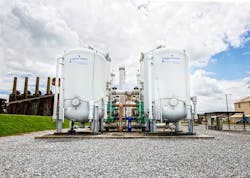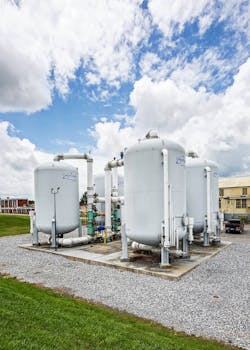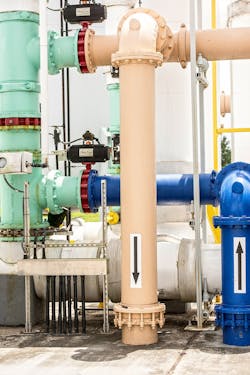About the author:
Christy Bostardi is marketing manager of drinking water solutions for Calgon Carbon. Bostardi can be reached at [email protected].
In 2010, Shelby County Water Services (SCWS) was planning for the future. With new regulations on the horizon, SCWS determined the Talladega/Shelby Water Treatment Plant (WTP) in Shelby County, Alabama, needed more effective removal of disinfection byproducts (DBPs). Specifically, the treatment plant needed help complying with the new U.S. EPA Stage 2 Disinfection Byproduct Rule (DBPR).
SCWS serves both retail and wholesale customers. The active wholesale customers, Alabaster, Pelham and Sterrett-Vandiver, sell significant amounts of water from SCWS to their customers. The number of SCWS retail customers, primarily located in Westover, Chelsea and the subdivisions of Eagle Point, Greystone, Forrest Park, Forrest Lakes, Mt. Laurel, Regent Park, Villas Belvedere and Highland Village, grew from about 3,200 in 2001 to more than 10,500 in 2010. Part of that increase was attributed to the acquisition of customers from the former Westover Water Authority, which merged with SCWS in 2007.
SCWS gets water from Lay Lake on the Coosa River and treats the water in two facilities: Talladega/Shelby WTP and Shelby County South WTP. The Shelby County South plant near Wilsonville is owned and operated by Shelby County and began production of drinking water treated with granular activated carbon (GAC) for DBP removal in 2008.
Over the course of the following year, SCWS considered GAC and ion exchange for use at the Talladega/Shelby plant to ensure compliance with Stage 2 DBPR regulations. Based on its analysis, the county concluded the cost and performance of a GAC system would be similar to the other options, assuming the carbon lasted at least one year before requiring reactivation.
Another consideration in the analysis was the location of the Talladega/Shelby plant because the remote location and lack of septic sewers favored a technology that resulted in minimal waste. Waste from the plant flows through a series of settlement lagoons and eventually is discharged into the Coosa River. These waste lagoons were not designed to treat high levels of color, total dissolved solids or salt, which can be typical of ion exchange waste. Furthermore, the Alabama Department of Environmental Management indicated a concentrated waste discharge would require special permits and significant testing for compliance. For these reasons, SCWS was drawn toward the GAC system, which characteristically results in little waste.
The county’s cost analysis showed the GAC filter design necessary to effectively remove DBPs for a full year before requiring reactivation. Calgon Carbon proposed its newest and largest GAC adsorption system, the Model-14. This system, equipped with two vessels that hold 60,000 pounds of GAC each, was developed as SCWS evaluated how best to upgrade the plant. Birmingham-based Municipal Consultants Inc., who played a large role in the design process for the plant, took notice of the new system.
“When Calgon Carbon released the 60,000-pound vessels, we were able to reduce the number of vessels we needed down to four,” said Chris Cousins, president of Municipal Consultants. “This saves money because with the larger size, we only have to reactivate two of them every fiscal year.”
In the end, the plant installed four of the 14-ft diameter Model-14 pressure vessels over a 10-month period. Filtered water is pumped through the GAC to remove the natural organic matter (NOM) from the source of water before disinfection, preventing the formation of DBPs. The system is designed to allow plant operators to pump either all or part of the filtered water through the vessels in either parallel or series operation.
Approximately every year, the county sends the spent GAC from two vessels to Calgon Carbon for custom reactivation. The spent GAC is transported to one of Calgon Carbon’s custom reactivation facilities, where it is thermally reactivated to remove adsorbed contaminants and restore its adsorption capacity. The filtration media company then returns and installs the reactivated carbon (including a small amount of virgin GAC to make up for losses in reactivation) into the Talladega/Shelby vessels. The entire reactivation process is performed according to the latest NSF and AWWA standards governing the reactivation of GAC used for drinking water treatment.
Ultimately, GAC was a wise selection of the treatment options that were considered because GAC is an effective removal technology that accomplishes more than just DBP compliance. GAC not only removes targeted contaminants of concern, such as natural organic matter (NOM) and DBPs, but it also acts as a defense barrier against accidental contamination by unregulated compounds like perfluorinated compounds (PFCs), pesticides and a number of other contaminants listed on the U.S. EPA’s Contaminant Candidate List 4 (CCL4).
Since the installation of the Model-14 vessels with GAC at the Talladega/Shelby plant, DBP levels throughout the distribution system have remained in compliance. Installation of the GAC systems preempted the impact of the Stage 2 DBPR, ensuring Shelby County’s water was in continuous compliance during the transition from Stage 1 to the more stringent Stage 2.
The affordability of the proposed solution, the availability of custom reactivation services and the large vessel design all were factors in SCWS’s choice to work with Calgon Carbon, according to Michael Cain, manager of water services for Shelby County.
“This was supplied as a complete system: carbon, vessels, pipes, pressure vessels and all,” Cain said. “Calgon Carbon has proven to be the right choice.”
What are DBPs & Why Are They Regulated?
Disinfecting water using chemical agents, such as chlorine is an essential part of public health, because it protects consumers from disease-carrying microorganisms. However, disinfectants react with NOM in the water to form compounds called DBPs. DBPs have been linked to a number of human health concerns and have been regulated by the U.S. EPA.
Some alternative disinfectants, such as chloramines and ozonation, do reduce the level of regulated DBPs but result in new, currently unregulated and still toxic DBPs. Many municipal water providers are taking the step of removing NOM from water before adding disinfectant chemicals, preventing the formation of both regulated and unregulated DBPs. Granular activated carbon (GAC) is one of the most commonly applied technologies used to remove NOM from water.
The U.S. EPA’s Stage 2 DBPR requires water systems meet disinfection maximum contaminant levels at each monitoring site in a distribution system.
What is Custom Reactivation?
Calgon Carbon has a dedicated NSF-approved reactivation plant in North Tonawanda, New York, that serves customers east of the Mississippi River.
This facility is used for custom municipal reactivation, meaning every customer’s carbon is segregated and processed separately from other customers’ carbon. During the reactivation process, organic compounds captured by GAC are destroyed when subjected to high temperatures that, at the same time, restore the GAC to a near-virgin state. This resulting reactivated product results in a cost savings. The reactivation/recycling process also is better for the environment, with a reduced CO2 footprint compared to the manufacture of virgin-activated carbon.
Model 14 Adsorption Vessels
Calgon Carbon’s Model-14 adsorption system uses GAC to remove dissolved organic contaminants, such as DBPs and NOM, from liquids. These vessels can hold up to 60,000 pounds of GAC providing the additional contact time to remove either compounds at low concentrations or poorly adsorbing compounds.
It is designed with one GAC fill line and three GAC discharge lines positioned to extract 20,000 pounds of spent carbon each. The arrangement of the discharge lines facilitates efficient GAC exchanges in three easily removed increments. In addition, three nozzles along the straight side of the vessel can be fitted with in-bed sample assemblies to allow the operator to monitor the mass transfer zone of the adsorbate through the bed.
The standard system is a single vessel, and typical designs include several single vessels operated in parallel. However, two vessel systems can also be provided for lead-lag operation.


